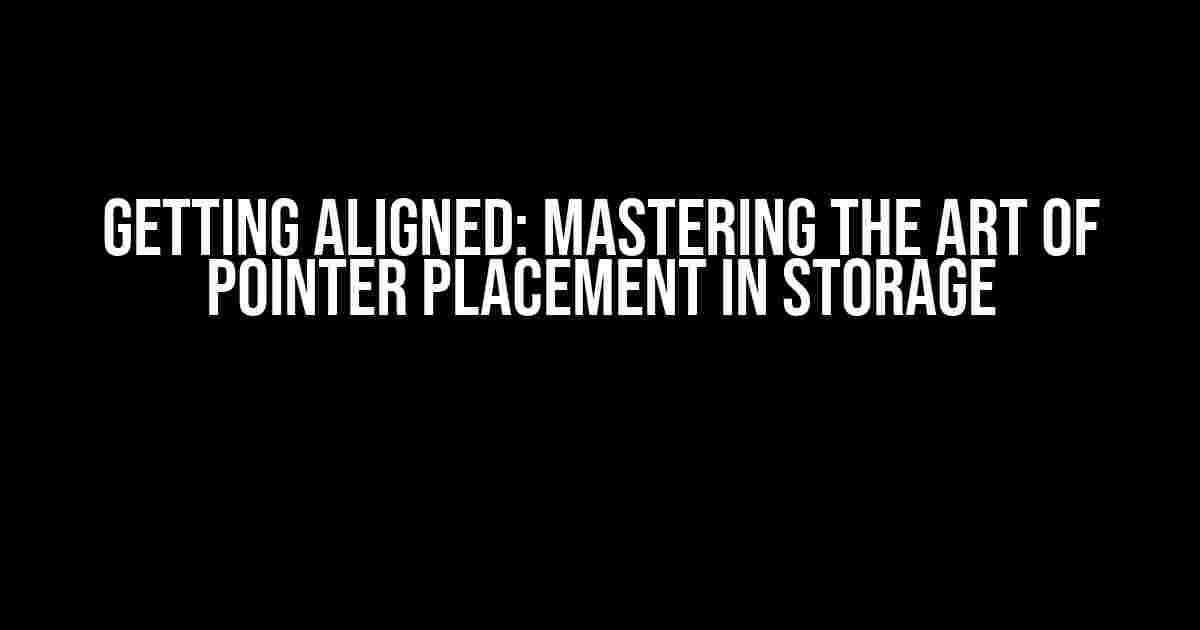_pointer, a fundamental concept in computer science, can be a daunting task for beginners. In this article, we’ll delve into the world of pointer alignment, providing a comprehensive guide on getting an aligned pointer inside storage to place an object. Buckle up, folks!
What is a Pointer?
A pointer is a variable that holds the memory address of another variable. In other words, it “points” to a location in memory where a value is stored. Think of it like a map that guides you to a specific location. Without a pointer, you wouldn’t be able to access or manipulate data in memory.
The Importance of Alignment
When working with pointers, alignment is crucial. Misaligned pointers can lead to:
- Memory corruption
- Crashes and errors
- Inconsistent behavior
- Security vulnerabilities
Proper alignment ensures that the pointer is correctly positioned to access the desired memory location. In this article, we’ll explore the steps to achieve alignment and get your pointer ready to place an object in storage.
Understanding Storage and Memory
To grasp pointer alignment, you need to understand the basics of storage and memory:
Memory Hierarchy
The memory hierarchy consists of:
- Main Memory (RAM)
- Caching
- Volatile Memory
- Non-Volatile Memory
Main memory, also known as RAM (Random Access Memory), is the primary storage for executing programs. Caching is a small, fast memory that stores frequently accessed data. Volatile memory loses its content when power is off, whereas non-volatile memory retains its data even when powered down.
Storage Classes
In C/C++, storage classes define the lifetime and scope of variables:
- Automatic Storage Class (Auto)
- Static Storage Class (Static)
- Dynamically Allocated Storage Class (Dynamic)
- Thread-Local Storage Class (Thread-Local)
Each storage class has its own memory management rules, and understanding these classes is vital for effective pointer management.
Getting Aligned: A Step-by-Step Guide
Now that we’ve covered the basics, let’s dive into the process of getting an aligned pointer inside storage to place an object:
Step 1: Declare and Initialize the Pointer
int *ptr; // declare a pointer to an integer ptr = (int*) malloc(sizeof(int)); // allocate memory for the pointer
In this example, we declare a pointer `ptr` to an integer and allocate memory for it using `malloc()`. The `(int*)` cast is essential to ensure the correct type.
Step 2: Check for Null Pointer
if (ptr == NULL) {
printf("Memory allocation failed\n");
exit(1);
}
Before proceeding, we check if the pointer is null. If `malloc()` fails to allocate memory, it returns a null pointer. In this case, we exit the program with an error message.
Step 3: Align the Pointer
#include// include the align.h header int alignment = alignof(int); // get the alignment of an integer ptr = (int*)((uintptr_t) ptr + (alignment - 1)) & ~(uintptr_t)(alignment - 1);
We include the `stdalign.h` header to access the `alignof()` macro, which returns the alignment of the type. We then use bit manipulation to align the pointer. The `(uintptr_t)` cast ensures we’re working with an unsigned integer type.
Step 4: Place the Object in Storage
int obj = 10; // create an integer object *ptr = obj; // store the object in the aligned pointer
Now that our pointer is aligned, we create an integer object `obj` and store it in the pointer using the dereference operator `*`.
Troubleshooting Common Issues
When working with pointers, common issues include:
null pointer dereference
if (ptr != NULL) {
*ptr = obj; // ensure the pointer is not null before dereferencing
}
Always check for null pointers before dereferencing to avoid program crashes.
Memory Leaks
free(ptr); // release the allocated memory when no longer needed
Don’t forget to free the allocated memory when you’re done using it to prevent memory leaks.
Conclusion
Getting an aligned pointer inside storage to place an object requires attention to detail and a solid understanding of pointer management. By following these steps and heeding the troubleshooting tips, you’ll be well on your way to becoming a master of pointer alignment. Remember, a well-aligned pointer is key to successful memory management and error-free programming.
| Keyword | Description |
|---|---|
| Pointer | A variable that holds the memory address of another variable |
| Alignment | The process of positioning a pointer to access a specific memory location |
| Storage Classes | Define the lifetime and scope of variables in C/C++ |
| malloc() | A function that dynamically allocates memory |
By mastering the art of pointer alignment, you’ll unlock the full potential of C/C++ programming and develop robust, efficient, and error-free code. Happy coding!
Frequently Asked Question
Get ready to tackle the most pressing concerns about getting aligned pointers inside storage to place objects!
What’s the deal with aligned pointers, and why do I need them?
Aligned pointers are crucial when working with storage and objects because they ensure that the memory address of the object is properly aligned with the memory architecture. This prevents memory access errors, improves performance, and avoids crashes. Think of aligned pointers as the perfect parking spot for your object – it’s essential for a smooth ride!
How do I determine the correct alignment for my object?
The correct alignment depends on the type of object and the memory architecture. In general, you can use the `alignof` operator in C or C++ to determine the alignment requirement of an object. This operator returns the alignment in bytes, so you can use it to calculate the correct memory offset. It’s like finding the perfect seat for your object – you need to know the exact dimensions to fit it snugly!
What happens if I don’t use aligned pointers?
If you don’t use aligned pointers, you might experience memory access errors, crashes, or incorrect behavior. This is because unaligned memory access can lead to data corruption, bus errors, or even security vulnerabilities. Think of it like trying to force a puzzle piece into the wrong spot – it might seem to fit, but it’ll cause problems down the line!
Can I use aligned pointers with dynamic memory allocation?
Yes, you can use aligned pointers with dynamic memory allocation. In fact, many memory allocation functions, such as `malloc` or `new`, provide options for specifying the alignment requirements. Make sure to check the documentation for the specific allocation function you’re using to ensure you’re getting the correct alignment. It’s like booking a room with a specific view – you need to request it ahead of time to get the perfect fit!
Are aligned pointers language-specific or platform-specific?
Aligned pointers are language-agnostic, but platform-specific. What this means is that the alignment requirements can vary between different platforms (e.g., x86, ARM, or PowerPC), but the concept of aligned pointers applies to multiple programming languages, including C, C++, and others. Think of it like packing luggage for a trip – you need to consider the specific airline’s requirements, but the act of packing is the same regardless of your destination!


